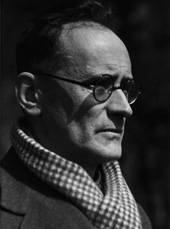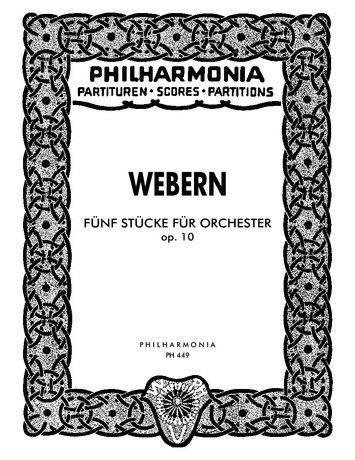

Anton Webern
5 Pieces
Short instrumentation: 1 1 2 0 - 1 1 1 0 - perc(4), hp, cel, harm, mand, guit, vln, vla, vc, cb
Duration: 6'
Instrumentation details:
flute (+picc)
oboe
clarinet in Eb
clarinet in Bb (+bass cl(Bb))
horn in F
trumpet in Bb
trombone
percussion(4 players): glockenspiel, xylophone, bells (some of them low), cow bells, triangle, cymbals, snare drum, bass drum
harp
celesta
harmonium
mandolin
guitar
violin
viola
violoncello
double bass
Webern - 5 Stücke op. 10 for orchestra
Printed/Digital
Translation, reprints and more

Anton Webern
Webern: 5 Pieces for orchestra - op. 10Orchestration: for orchestra
Type: Taschenpartitur

Anton Webern
Webern: 5 Stücke - op. 10Orchestration: for orchestra
Type: Partitur (Sonderanfertigung)
Sample pages
Audio preview
Work introduction
Like the Op. 9 Bagatelles, these orchestra pieces have a complicated origin. Two of them (nos. 1 and 4) were written in 1911, the other three in 1913, along with a larger number – some merely sketched, some completed, and some including a singing voice. Webern conducted the premiere in Zurich in 1926.
The instrumental forces of Op. 10 are actually a chamber orchestra: the winds and strings one-to-a-part and the small complement of instruments never used in full. The use of harmonium, mandolin, guitar, celesta, bells and cowbells were certainly suggested by Mahler (Symphonies 6 through 8), whom Webern passionately admired. As with the Bagatelles written at the same time, everything is reduced to its essentials; the fourth piece, only six bars long, is the shortest one Webern ever composed, and only the last one, 31 bars long, attains the dimensions of Opp. 5 and 6. However, everything here has become quieter, subcutaneous. Schönberg’s notion of Klangfarbenmelodie doubtless plays a certain part in the orchestration; for example, the thrice-repeated F at the end of the first piece is scored differently each time: first, the flute alone, then flute and muted trumpet, then trumpet alone and finally celesta. These pieces are surely among the most beautiful and disciplined of all Webern’s works.
Manfred Angerer
